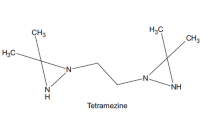Summary
The binding of chlorthalidone to human blood components has been studied in vitro. The drug was preferentially taken up by red blood cells, the partition ratio between plasma and the cell fraction being dependent on the drug concentration. When the concentration of chlorthalidone in blood was less than 15–20 µg/ml, more than 98% of the compound was bound to red cells. Increasing the concentration resulted in an abrupt change of the partition ratio in favour of plasma, which indicates a saturable receptor for chlorthalidone in red cells, namely carbonic anhydrase (HCA). The association constant of the drug-enzyme complex KassHCA was 2.76×106 l/mole. For the two major isoenzymes of carbonic anhydrase, HCA-B and HCA-C, the association constants were different: KassHCA-B=2.43×106 l/mole and KassHCA-C=5.69×106 l/mole. The number of binding sites n=1 in all cases. In human serum at 37°C, over a concentration range of 0.02–7.7 µg/ml, 75.7% of chlorthalidone was bound to proteins. The major portion of the binding was to albumin (HSA), the association constant of the complex KassHSA=1.18×103 l/mole and the number of binding sites n=4. The much higher association constant of chlorthalidone with HCA than with HSA can account for selective uptake of the drug by red cells.
Similar content being viewed by others
References
Graf, W., Girod, E., Schmid, E., Stoll, W.G.: Zur Konstitution von Benzophenon-2-Carbonsäure-Derivaten. Helv. chim. Acta42, 1085–1101 (1959)
Reutter, F., Schaub, F.: Klinische Untersuchungen und Erfahrungen mit Hygroton, einem neuartigen, oral wirksamen Diuretikum. Schweiz. med. Wschr.89, 1158–1165 (1959)
Stenger, E.G., Wirz, H., Pulver, R.: Hygroton (G 33 182), ein neues Salidiureticum mit protrahierter Wirkung. Schweiz. med. Wschr.89, 1126–1130 (1959)
Leppla, W., Buech, H., Jutzler, G.A.: Die diuretische und saluretische Wirkung von Hygroton. Dtsch. med. Wschr.85, 1591–1598 (1960)
Frank, H., Dentler, H., Eberlein, F., Schmid, E.: Untersuchungen über ein blutdrucksenkendes Diureticum mit langer Wirkungsdauer. Arzneimittel-Forsch.10, 434–440 (1960)
Reutter, F., Schaub, F.: Erfahrungen in der Hypertoniebehandlung mit Chlorthalidon. Praxis51, 918–921 (1962)
Arnold, O.H.: Therapie der essentiellen Hypertonie. Dtsch. med. Wschr.90, 36–38 (1965)
Pulver, R., Stenger, E.G., Exer, B.: Über die Hemmung der Carboanhydratase durch Saluretica. Naunyn-Schmiedeberg's Arch. exp. Path. Pharmak.244, 195–210 (1962)
Stenger, E.G., Wirz, H.: Pharmakologie und Wirkungsmechanismus von Hygroton®. Chemotherapia1 254–263 (1960)
Beermann, B., Hellstroem, K., Lindstroem, B., Rosén, A.: Binding-site interaction of chlorthalidone and acetazolamide, two drugs transported by red blood cells. Clin. Pharmacol. Ther.17 424–432 (1975)
Beisenherz, G., Koss, F.W., Klatt, L., Binder, B.: Distribution of radioactivity in the tissues and excretory products of rats and rabbits following administration of14C-Hygroton. Arch. int. Pharmacodyn.161 76–93 (1966)
Tweeddale, M.G., Ogilvie, R.J.: Improved method for estimating chlorthalidone in body fluids. J. pharm. Sci.63 1065–1068 (1974)
Riess, W., Dubach, U.C., Burckhardt, D., Theobald, W., Vuillard, P., Zimmerli, M.: Pharmacokinetic studies with chlorthalidone (Hygroton®) in man. Manuscript in preparation.
Kalberer, F., Rutschmann, J.: Eine Schnellmethode zur Bestimmung von Tritium, Radiokohlenstoff und Radioschwefel in beliebigem organischen Probenmaterial mittels des Flüssigkeits-Scintillations-Zählers. Helv. chim. Acta44 1956–1966 (1961)
Armstrong, J.McD., Myers, D.V., Verpoorte, J.A., Edsall, J.T.: Purification and properties of human erythrocyte carbonic anhydrases. J. biol. Chem.241 5137–5149 (1966)
Philpot, F.J., Philpot, I.S.L.: A modified colorimetric estimation of carbonic anhydrase. Biochem. J.30 2191–2193 (1936)
Rickli, E.E., Ghazanfar, S.A.S., Gibbons, B.H. Edsall, J.T.: Carbonic anhydrases from human erythrocytes. J. biol. Chem.239 1065–1078 (1964)
Lund, J., Buus Lassen, J., Squires, R.F.: The distribution of 2-amino-4-phenylsulphonylbenzenesulphonamide (NSD 3004) in blood and its binding to blood components. Acta pharmacol. (Kbh.)30 17–28 (1971)
Weder, H.G., Schildknecht, J., Kesselring, P.: A new equilibrium dialyzing system. Amer. Lab.10 15–21 (1971)
Weder, H.G., Bickel, M.H.: Verbessertes Gerät zur Gleichgewichts-Dialyse. Z. Anal. Chem.252 253–255 (1970)
Scatchard, G.: The attraction of proteins for small molecules and ions. Ann. N.Y. Acad. Sci.51 660–672 (1949)
Fletscher, J.E., Spector, A.A.: A procedure for computer analysis of data from macromolecule-ligand binding studies. Computers and Biomedical Res.2 164–175 (1968)
Maren, T.H.: Carbonic anhydrase: chemistry, physiology, and inhibition. Physiol. Rev.47 595–781 (1967)
Coleman, J.E.: Chemical reactions of sulfonamides with carbonic anhydrase. Ann. Rev. Pharmacol.15 221–242 (1975)
Coleman, J.E.: Carbonic anhydrase. In: Inorganic biochemistry (ed. G. Eichhorn) Vol. I, p. 488–548. Amsterdam, London, New York: Elsevier Scientific Publishing Company 1973
Author information
Authors and Affiliations
Rights and permissions
About this article
Cite this article
Dieterle, W., Wagner, J. & Faigle, J.W. Binding of chlorthalidone (Hygroton®) to blood components in man. Eur J Clin Pharmacol 10, 37–42 (1976). https://doi.org/10.1007/BF00561547
Received:
Revised:
Accepted:
Issue Date:
DOI: https://doi.org/10.1007/BF00561547




